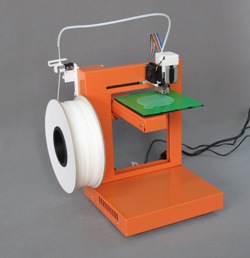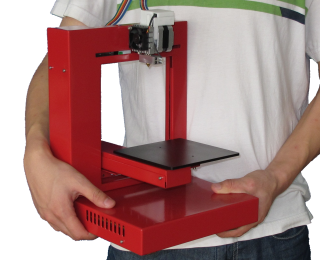A new 3D printer from China seems to have solved the issues that have plagued other low-cost competitors.
By L. Stephen Wolfe, P.E.

When 3D printing systems (also called stereolithography or rapid prototyping systems) appeared in 1988 they sold for an eye-popping quarter-million bucks. At the time, many people believed that 3D printer prices would fall over the next couple of decades much like large–format 2D plotters had fallen during the 1980s and 1990s. 2D plotters that had sold for more than $50,000 in 1981 had dropped to under $2,000 by the turn of the century.
3D printer prices have followed a more gradual trajectory, however. In 1992 Stratasys’ 3D Modeler listed for $85,000. Today Stratasys’ Dimension 1200es lists for $24,900. Several companies have announced 3D printers with list prices below $10,000, but most of these products have suffered from poor reliability and part quality. The under-$3,000 Solido “smelled so bad we had to put it in the basement,” according to one CAD company executive. While 3D printers aimed for the hobbyist market are in the sub-$2500 range, 3D printers that would attract a professional audience with ease-of-use, reliability, and the ability to use industry-standard technologies like fused deposition modeling and superior materials like ABS plastic are still more expensive.
The game has changed with the Up! 3D printer from [X] Object, the North American distributor for PP3DP of Beijing, China. The company exhibited for the first time at SolidWorks World 2012, offering a “show special” price of $1,499 good through February 22. [X] Object has been selling the desktop systems since December 2010 and claims PP3DP has sold thousands worldwide.
The Up! printer employs the fused deposition modeling process pioneered by Stratasys. Its material is ABS filament and layers may be adjusted between 0.4 and 0.2 mm. The surface finish is good—for FDM.
As one would expect from its price, the building volume is relatively small: 5½ inches (140 mm) square and 5¼ inches (135 mm) tall. In contrast, Stratasys’ Dimension 1200es can make parts as large as 10 inches (254 mm) by 10 inches by 12 inches (305 mm.) But the Up! fabricator weighs just 11 pounds (5 kg) and occupies less than a square foot (.1 square meters) of desk space. The Dimension 1200es is the size of a refrigerator and weighs 326 pounds (148 kg).

Lonnie Knechtel bought his own Up! 3D printer in 2011 to help make parts for one-inch-scale model railroads, his hobby and side business (http://www.oneinchrr.com). He says the Up! 3D printer is reliable and capable of making hollow parts with great finish that look as if they were solid. Break-off supports are easy to remove and the software that comes with the Up! system is “getting better.”
[X] Object supplies software for Windows personal computers that reads STL files and positions them on a virtual building platform of the Up! printer. The printer connects to the PC via a USB cable. Once models are downloaded to the printer for building, the USB cable may be disconnected and the printer left to run by itself. There is no direct SolidWorks software interface as yet.
ABS for the Up! system comes in 10 colors (including white) and costs $55 per pound. The regular price of the version 1.1 machine is $3,250. The previous 1.0 model is marked down to $1,250 while supplies last. Each machine comes with a one-year parts warranty. Customers are expected to install their own parts. A one-year extension of the warranty is $200 plus shipping for any parts ordered. For more information, visit http://www.up3dusa.com/ or http://www.x-object.com/
Competition beware
Stratasys’ Dimension subsidiary needs to react quickly unless it wants to go the way of Calcomp, the inventor of large-format computer-driven pen plotters that was driven out of business by Hewlett-Packard. HP undercut Calcomp’s prices through clever design. PP3DP not only has a simpler design but makes its products with lower-cost labor. It’s not hard to imagine how PP3DP could make larger models of its simple machine that would sell for attractive prices.
L. Stephen Wolfe, P.E. is a Jon Peddie Research contributing analyst.





